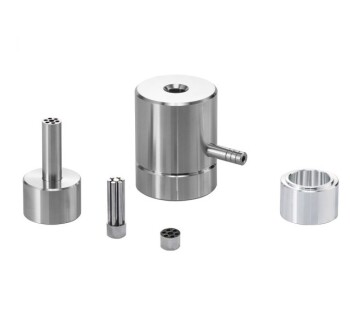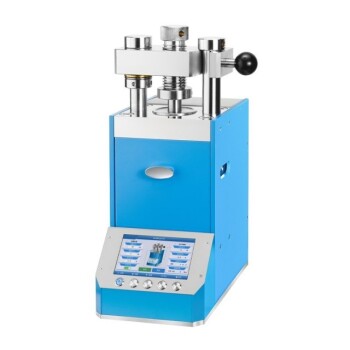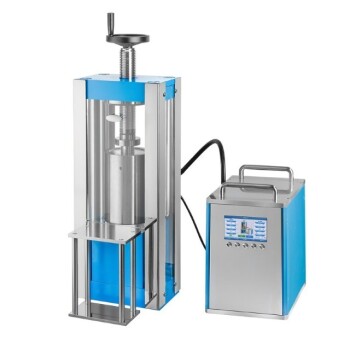In a hydraulic press, force is multiplied by using a confined, incompressible fluid to transmit pressure from a small area to a large area. When a small input force is applied to a small piston, it creates pressure throughout the fluid. This same pressure then acts on a much larger piston, generating a significantly larger output force.
A hydraulic system does not create energy; it trades distance for force. By applying a small force over a long distance on an input piston, you generate a massive force that moves a short distance on the output piston, all governed by the principle that pressure remains constant within a confined fluid.
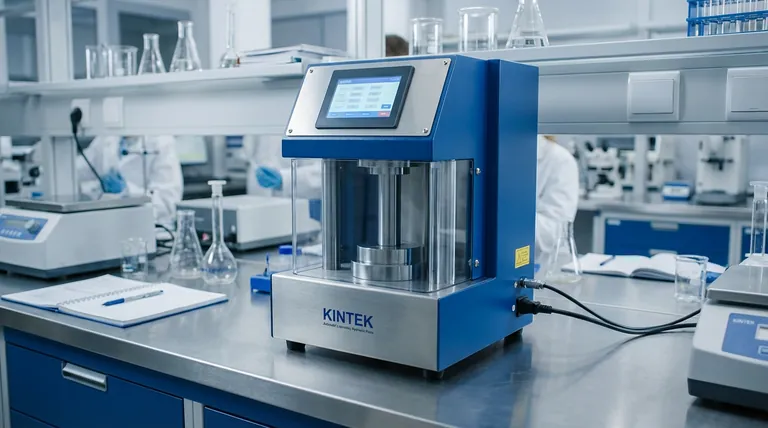
The Core Principle: Pascal's Law Explained
What is Pascal's Law?
Pascal's Law is the fundamental principle behind hydraulics. It states that a pressure change at any point in a confined, incompressible fluid is transmitted equally and undiminished to every portion of the fluid and the walls of its container.
Visualizing Pressure Transmission
Imagine squeezing a sealed water balloon. The pressure you apply with your fingers is felt equally across the entire surface of the balloon, not just in the spot you are squeezing. A hydraulic system operates on this same principle, but within a more controlled environment.
The Role of the Incompressible Fluid
For this law to work effectively, the fluid (typically a specialized oil) must be incompressible. This means its volume does not noticeably decrease under pressure. This ensures that the force applied is used to move the piston, not to compress the fluid itself.
How a Hydraulic Press Achieves Force Multiplication
The Two-Piston System
A hydraulic press consists of two connected cylinders, each with a piston of a different size. The smaller piston is the input piston (or plunger), where the initial force is applied. The larger piston is the output piston (or ram), which performs the work.
Step 1: Creating Pressure
Pressure (P) is defined as Force (F) applied over an Area (A), or P = F/A. When a small force (F1) is applied to the small input piston (with area A1), it generates pressure within the fluid.
Step 2: Transmitting the Pressure
According to Pascal's Law, this pressure (P) is transmitted equally throughout the entire hydraulic fluid. The same pressure that exists under the small piston is now present under the large output piston.
Step 3: Generating the Output Force
This constant pressure (P) now acts on the larger area (A2) of the output piston. The resulting output force (F2) can be calculated as F2 = P * A2. Because A2 is much larger than A1, F2 becomes proportionally much larger than the initial input force, F1.
For example, if the output piston has 20 times the surface area of the input piston, the output force will be 20 times the input force.
Understanding the Trade-offs: No "Free Lunch"
Conservation of Energy
Hydraulic multiplication can seem like getting something for nothing, but it fully adheres to the law of conservation of energy. The work done on the input side must equal the work done on the output side (ignoring minor losses from friction).
The Real Cost: Force vs. Distance
Work is calculated as Work = Force x Distance. To generate a massive output force, you must pay a price in distance.
To achieve a 20x force multiplication, the small input piston must travel 20 times farther than the large output piston moves. You are trading a long, easy push for a short, powerful one.
Why Hydraulic Oil is Ideal
While water could work in theory, specialized hydraulic oils are used because they are not only incompressible but also lubricate the system's moving parts, protect against corrosion, and have a high boiling point to resist heat generated by friction and pressure.
Making the Right Choice for Your Application
Understanding the core principles allows you to see how hydraulic systems are tailored to specific tasks.
- If your primary focus is to maximize force: The key is to maximize the area ratio between the output piston (ram) and the input piston (plunger).
- If your primary focus is system design: Remember that every gain in force comes with a proportional decrease in travel distance. You must balance power with the required range of motion.
- If your primary focus is troubleshooting a "spongy" system: The most likely culprit is air trapped in the hydraulic lines. Air is compressible, so applied force is wasted on squeezing the air bubbles instead of being transmitted efficiently.
By mastering the simple but profound relationship between pressure, area, and distance, you can harness the immense power of hydraulic systems.
Summary Table:
| Key Aspect | Description |
|---|---|
| Pascal's Law | Pressure change in confined fluid is transmitted equally and undiminished. |
| Force Multiplication | Output force increases with larger piston area, e.g., 20x force for 20x area ratio. |
| Trade-off | Force gain requires input piston to move farther; energy is conserved. |
| Ideal Fluid | Incompressible hydraulic oil ensures efficient pressure transmission and system protection. |
Maximize your lab's efficiency with KINTEK's hydraulic presses! Our automatic lab presses, isostatic presses, and heated lab presses are designed to deliver precise force multiplication for your research and testing needs. Experience reliable performance and tailored solutions—contact us today to discuss how we can support your laboratory goals!
Visual Guide
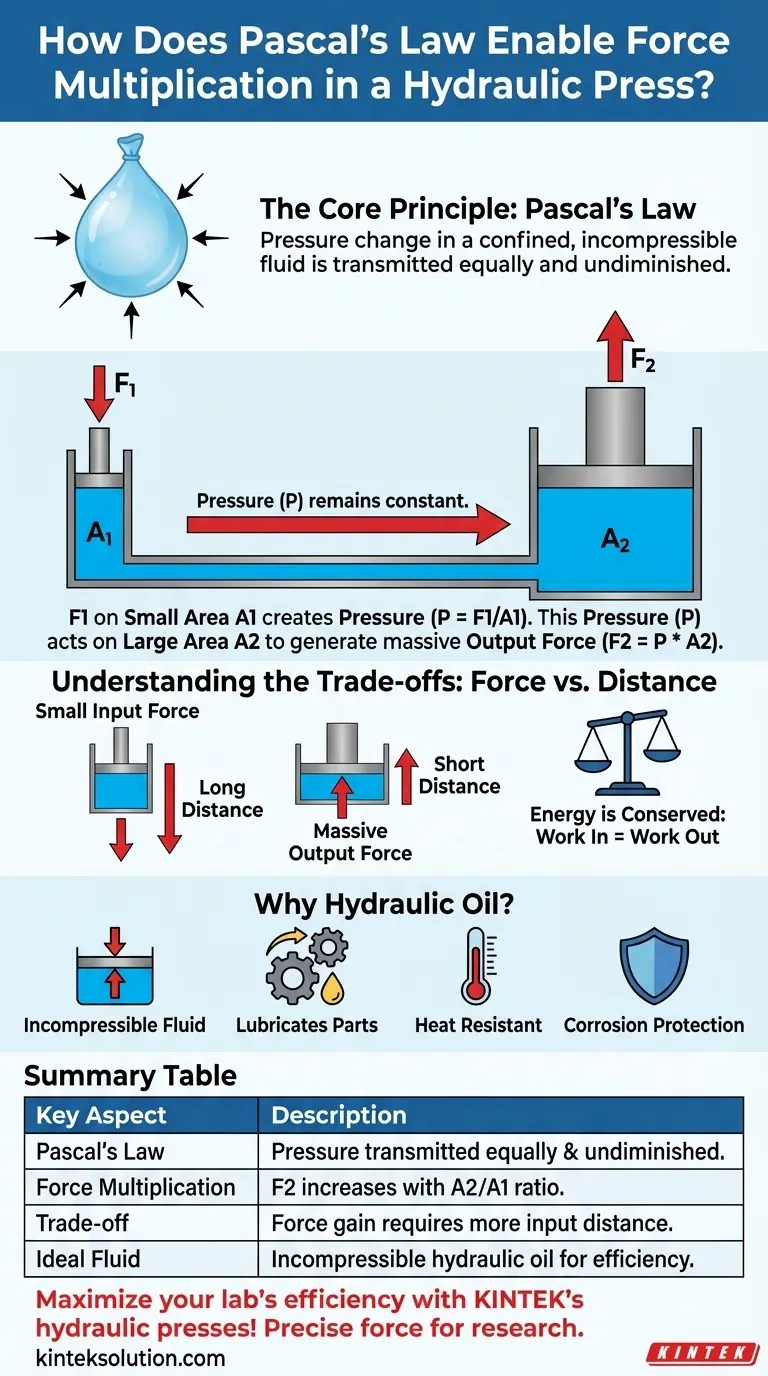
Related Products
- Automatic Laboratory Hydraulic Press Lab Pellet Press Machine
- Laboratory Hydraulic Press 2T Lab Pellet Press for KBR FTIR
- Laboratory Hydraulic Press Lab Pellet Press Button Battery Press
- Manual Laboratory Hydraulic Press Lab Pellet Press
- Automatic Laboratory Hydraulic Press for XRF and KBR Pellet Pressing
People Also Ask
- How are hydraulic presses used in the preparation of powder mixtures? Achieve Precise Compaction for Accurate Analysis
- How do hydraulic press machines ensure precision and consistency in pressure application? Achieve Reliable Force Control for Your Lab
- How do hydraulic pellet presses contribute to material testing and research? Unlock Precision in Sample Prep and Simulation
- How does a hydraulic press aid in XRF spectroscopy? Achieve Accurate Elemental Analysis with Reliable Sample Prep
- How are hydraulic pellet presses used in educational and industrial settings? Boost Efficiency in Labs and Workshops

















